| Author |
Message |
|
Sjouke de Jong
|
 Posted: Wed 07 Sep, 2011 5:56 am Post subject: Early Cutlass techniques? Posted: Wed 07 Sep, 2011 5:56 am Post subject: Early Cutlass techniques? |
 |
|
Hello everyone!
Duo to my great enthusiasm of Piracy in the 17th and early 18th century, I've decided I want to learn/study how these sea going Robbers (and other sailors) used their edged weapons. In particular their primary sword, the Cutlass/hanger
Their however is a problem... I don't know what techniques they used when fighting close range combat using these short swords.
Many state that the Cutlass is a short saber. This then could simply mean that Cutlass techniques where identical to saber techniques like Cold steel claims:
http://www.youtube.com/watch?v=B7VBxc8WsXc
However There are no books about Cutlass techniques from the 17th or early 18th century. The earliest one dates back to the late 18th century. But are these the same techniques as a century ago? Or have they bin advances before written down?
Another set of techniques that looks a lot like the fencing methods Pirates used are the Langes Messer techniques (see attachments)
They also look like cutlasses. Esspecially when looking at a number of Pirate cutlass examples (see attachments)
Could it be that 17th and early 18th century Cutlass techniques where identical to these Langes Messer techniques?
Or where they perhaps a combination of various hacking sword techniques?
Perhaps it depended on what type of Cutlass you had,
as some cutlasses where longer and or thinner: http://kultofathena.com/product.asp?item=500968
As others where shorter and or wider: http://kultofathena.com/product.asp?item=500920
Can anyone help me with these puzzling questions?
Yours sincerely,
Sjouke de Jong
 Attachment: 153.35 KB Attachment: 153.35 KB
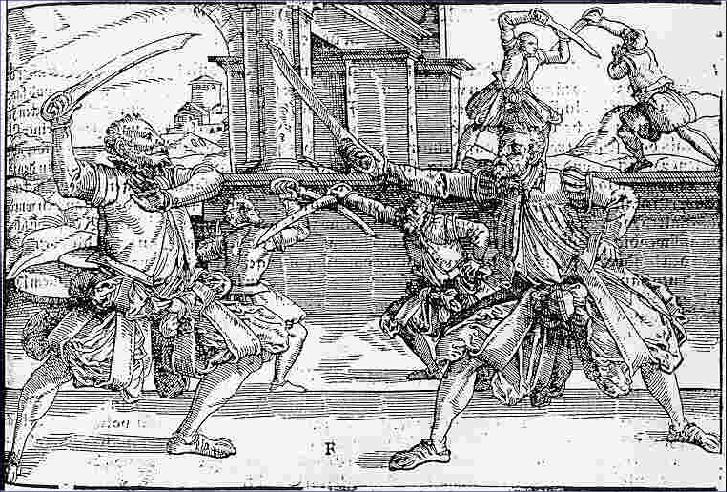
Langes Messer techniques 01.
 Attachment: 67.19 KB Attachment: 67.19 KB
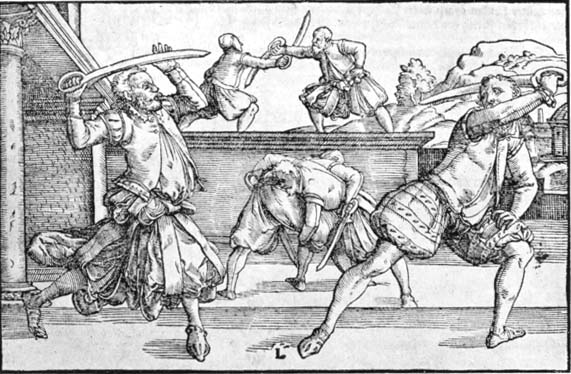
Langes messer techniques 02
 Attachment: 182.78 KB Attachment: 182.78 KB
Pirate cutlass examples 01, Richard Worley [ Download ]
 Attachment: 215.21 KB Attachment: 215.21 KB
Pirate cutlass examples 01, John Gow [ Download ]
|
|
    |
 |
Michael Curl

Location: Northern California, US Joined: 06 Jan 2008
Posts: 487
|
 Posted: Wed 07 Sep, 2011 7:58 am Post subject: Posted: Wed 07 Sep, 2011 7:58 am Post subject: |
 |
|
I think those are dussack's. Even if they aren't exactly accurate, I would think that practicing dussack would be a lot of fun and give you some potential insights.
E Pluribus Unum
|
|
   |
 |
Mackenzie Cosens

Location: Vancouver Canada Joined: 08 Aug 2007
Posts: 238
|
|
  |
 |
|
Sjors B
Location: Zevenaar, The Netherlands Joined: 31 Aug 2011
Posts: 43
|
 Posted: Wed 07 Sep, 2011 9:23 am Post subject: Posted: Wed 07 Sep, 2011 9:23 am Post subject: |
 |
|
In the posted pictures they indeed use dussack, i've heard they ware used as wooden training weapons for langes messer.
on Cutlass techniques you migth want to check this site: http://www.hroarr.com/manuscripts_sabre.php
has all sorts of manuscripts on country of origin, type of weapon, period etc.
member of the langenort school for European martial arts in Nijmegen (NL)
http://www.historicalshows.com/
|
|
   |
 |
|
Julian Reynolds
Location: United Kingdom Joined: 30 Mar 2008
Posts: 271
|
 Posted: Wed 07 Sep, 2011 10:11 am Post subject: Posted: Wed 07 Sep, 2011 10:11 am Post subject: |
 |
|
A few years ago, we did quite a bit of boarding action in my WMA class with Mark Donnelly (who moved on to instruct at the Historical Maritime Combat Association). There were no contemporary cutlass texts to work from, so we did a mix of various earlier and later styles that seemed to work well, but a lot of it was very simplistic and 'brutal'.
Some of the things I remember distinctly was the speed and viciousness and close-in nature of the cutlass work. Essentially we would be split into two groups, the boarders and their opponents. The job of the boarder was to get past his opponent as quickly and efficiently as possible (ie. get firmly on board the ship and past the first line of men barring his way). This was very explosive and fast. Once past, a cutlass blow to the back of the head/neck, or stab/slash in the back, and the boarder carried on the momentum into the next line of opponents, where things could progress at a more 'gentlemanly' pace. We used musket/bayonet to repel boarders, as well as cutlass and pikes.
There was nothing refined about the whole process, as it was pointed out that an ordinary sailor would probably not have had much practice with his cutlass, as this would be issued to him moments before the boarding action (you certainly wouldn't be wearing one doing your duties). Likewise the pikes. Only the marines would have an issue weapon they trained in (the musket/bayonet). As an ordinary sailor you probably had more experience stickfighting, fistfighting (pugilism) or knife fighting than you would have with a cutlass.
The quick, simple and brutal methods were the best, I recall.
Julian
|
|
  |
 |
|
Sjouke de Jong
|
 Posted: Wed 07 Sep, 2011 10:59 am Post subject: Posted: Wed 07 Sep, 2011 10:59 am Post subject: |
 |
|
| Michael Curl wrote: | | I think those are dussack's. Even if they aren't exactly accurate, I would think that practicing dussack would be a lot of fun and give you some potential insights. |
Your right, they indeed are Dussack's. I didn't know of this weapon until now...
These training weapons would indeed be of much use to me, as they where specifically used for training single edges weapons like Langes Messer and Cutlass.
Thanks for the insight!
|
|
    |
 |
|
Sjouke de Jong
|
 Posted: Wed 07 Sep, 2011 11:32 am Post subject: Posted: Wed 07 Sep, 2011 11:32 am Post subject: |
 |
|
| Julian Reynolds wrote: | A few years ago, we did quite a bit of boarding action in my WMA class with Mark Donnelly (who moved on to instruct at the Historical Maritime Combat Association). There were no contemporary cutlass texts to work from, so we did a mix of various earlier and later styles that seemed to work well, but a lot of it was very simplistic and 'brutal'.
Some of the things I remember distinctly was the speed and viciousness and close-in nature of the cutlass work. Essentially we would be split into two groups, the boarders and their opponents. The job of the boarder was to get past his opponent as quickly and efficiently as possible (ie. get firmly on board the ship and past the first line of men barring his way). This was very explosive and fast. Once past, a cutlass blow to the back of the head/neck, or stab/slash in the back, and the boarder carried on the momentum into the next line of opponents, where things could progress at a more 'gentlemanly' pace. We used musket/bayonet to repel boarders, as well as cutlass and pikes.
There was nothing refined about the whole process, as it was pointed out that an ordinary sailor would probably not have had much practice with his cutlass, as this would be issued to him moments before the boarding action (you certainly wouldn't be wearing one doing your duties). Likewise the pikes. Only the marines would have an issue weapon they trained in (the musket/bayonet). As an ordinary sailor you probably had more experience stickfighting, fistfighting (pugilism) or knife fighting than you would have with a cutlass.
The quick, simple and brutal methods were the best, I recall.
Julian |
Awesome class! ... We don't have anything like that in the Netherlands..... 
Thank you so much for sharing the conclusions of this experiment with me!
All you mentioned makes perfect sense.
However although Pirate crews usually where larger then most merchant crews, which gave them a great advantage in battle when using these tactics. there where cases in which Pirate crews where very close to the size of their prey's crew, and still came out of a battle victorious. This means that they where very powerful and skilled in combat. This could be the type of combat you referred to. It could primarily be their tactics of creating panic and confusion amongst their victims, using terror to make them surrender as quickly as possible. or it could be that they where more trained with their weaponry the common sailors.
Indeed this was the case with the Dutch female Pirate Nellie Cuyper. As she joined the Pirate crew that attacked the Dutch ship she was serving on (in men's clothing) the Pirates taught her how to use the cutlass and dagger. This is an example that there where Pirates that trained their newcomers in sword tactics.
|
|
    |
 |
|
Sjouke de Jong
|
 Posted: Wed 07 Sep, 2011 11:41 am Post subject: Posted: Wed 07 Sep, 2011 11:41 am Post subject: |
 |
|
| Sjors B wrote: | In the posted pictures they indeed use dussack, i've heard they ware used as wooden training weapons for langes messer.
on Cutlass techniques you migth want to check this site: http://www.hroarr.com/manuscripts_sabre.php
has all sorts of manuscripts on country of origin, type of weapon, period etc. |
Thanks a bunch for the link!
This could also indeed be very useful to me. especially the book on broadswords of 1797.
Being the 18th century these moves are most likely very similar to the techniques used in 1700-1730. Or at least the basics...
|
|
    |
 |
|
Sjors B
Location: Zevenaar, The Netherlands Joined: 31 Aug 2011
Posts: 43
|
 Posted: Wed 07 Sep, 2011 12:05 pm Post subject: Posted: Wed 07 Sep, 2011 12:05 pm Post subject: |
 |
|
| Sjouke de Jong wrote: | | Michael Curl wrote: | | I think those are dussack's. Even if they aren't exactly accurate, I would think that practicing dussack would be a lot of fun and give you some potential insights. |
Your right, they indeed are Dussack's. I didn't know of this weapon until now...
These training weapons would indeed be of much use to me, as they where specifically used for training single edges weapons like Langes Messer and Cutlass.
Thanks for the insight! |
if your interested in training with langes messer you should check the manuscripts of Johannes leckuchner, or visit us in nijmegen, we are training with messer this season
member of the langenort school for European martial arts in Nijmegen (NL)
http://www.historicalshows.com/
|
|
   |
 |
|
Julian Reynolds
Location: United Kingdom Joined: 30 Mar 2008
Posts: 271
|
 Posted: Wed 07 Sep, 2011 2:11 pm Post subject: Posted: Wed 07 Sep, 2011 2:11 pm Post subject: |
 |
|
The confined, explosive nature of the fighting was reflected in the techniques we practised:
The main guard was against the most common attack one would encounter with such a short-bladed weapon used in a confined space by a relative novice; a simple downwards cut into the head/shoulders. The cutlass was held just above the head across the body (ie. in the line of the shoulders), point slightly forward and lowered, and the blade supported by the offhand. Lean into the guard to add weight and strength to it. In this way, a powerful downward blow by an attacker with momentum could be blocked and deflected and a downward cut given back in riposte. Very basic!
Guarding the torso from the next most common attack (a slash across the thorax or a thrust) was done with a similar guard to the above but lowered and turned through 90 degrees; vaguely similar to tierce but much 'tighter' ie. hilt down and just forward of the right hip (not held out in tierce), blade slightly angled across the body with the tip forward and supported from behind with the offhand. Again lean into the guard to add weight to it. A powerful cut into the body would be blocked and directed down into the guard, with the riposte being a thrust into the chest or face (or even a punch in the face with the guard!).
And doing this 'en masse' shoulder to shoulder makes all the 'twirly' moulinets found in sabre/backsword cuts pretty redundant. It is very, very simple and works well at speed and in close proximity. And if your opponent blocks you, and you can't bludgeon your way through, roll around him and chop him down from behind!
Good fun, especially against marines and their muskets/bayonets.....
|
|
  |
 |
|
Sjouke de Jong
|
 Posted: Wed 07 Sep, 2011 2:57 pm Post subject: Posted: Wed 07 Sep, 2011 2:57 pm Post subject: |
 |
|
| Julian Reynolds wrote: | The confined, explosive nature of the fighting was reflected in the techniques we practised:
The main guard was against the most common attack one would encounter with such a short-bladed weapon used in a confined space by a relative novice; a simple downwards cut into the head/shoulders. The cutlass was held just above the head across the body (ie. in the line of the shoulders), point slightly forward and lowered, and the blade supported by the offhand. Lean into the guard to add weight and strength to it. In this way, a powerful downward blow by an attacker with momentum could be blocked and deflected and a downward cut given back in riposte. Very basic!
Guarding the torso from the next most common attack (a slash across the thorax or a thrust) was done with a similar guard to the above but lowered and turned through 90 degrees; vaguely similar to tierce but much 'tighter' ie. hilt down and just forward of the right hip (not held out in tierce), blade slightly angled across the body with the tip forward and supported from behind with the offhand. Again lean into the guard to add weight to it. A powerful cut into the body would be blocked and directed down into the guard, with the riposte being a thrust into the chest or face (or even a punch in the face with the guard!).
And doing this 'en masse' shoulder to shoulder makes all the 'twirly' moulinets found in sabre/backsword cuts pretty redundant. It is very, very simple and works well at speed and in close proximity. And if your opponent blocks you, and you can't bludgeon your way through, roll around him and chop him down from behind!
Good fun, especially against marines and their muskets/bayonets..... |
Nice techniques! Thanks for sharing!
How did you find these? What sort of sword does one officially use for these techniques? And what period of time do these techniques come from?
One more question. Don't Cutlass techniques tend to have the user keep his/her offhand out of harms way enough to prevent it being hit, but close enough to grab ones opponent when given the right time?
|
|
    |
 |
|
Sjouke de Jong
|
 Posted: Wed 07 Sep, 2011 3:17 pm Post subject: Thanks! Posted: Wed 07 Sep, 2011 3:17 pm Post subject: Thanks! |
 |
|
Thank you all for the replies!
I've truly learned more regarding Pirate/sailor's cutlass techniques so far.
I however have some examples of possibly historical accurate (or close to it) cutlass techniques:
http://www.youtube.com/watch?v=R-qpedUbxBc
http://www.youtube.com/watch?v=Ne2He-2pZVE&NR=1
And here is an example of techniques using 2 cutlasses:
http://www.youtube.com/watch?v=zUtQfu-1OUc&NR=1
Not sure how accurate these techniques are, but they seem pretty realistic and accurate for the fighting style.
So what techniques are they using here?
The double cutlass techniques differ from using a single cutlass (obviously) What kind of techniques are those?
I hope you can help me ones more.
Yours sincerely,
Sjouke de Jong
|
|
    |
 |
|
Julian Reynolds
Location: United Kingdom Joined: 30 Mar 2008
Posts: 271
|
 Posted: Wed 07 Sep, 2011 3:29 pm Post subject: Posted: Wed 07 Sep, 2011 3:29 pm Post subject: |
 |
|
We used the most commonly available ones we could find - ACW cutlasses (1860?) - as they are pretty much of a muchness when it comes to a generic short, curved-blades cutlass or hanger with a hefty guard. And they are readily available, easily blunted, and sturdy. They do, however, hurt like hell if you get hit. I have made up some cutlass wasters (with a straight 'blade') from hazel sticks from old walking sticks and nylon guards (see below) for those of us wary of using steel.
As for techniques, well, as I said in my first post, there are no contemporary cutlass treatises (please correct me if I'm wrong) so it was a mish-mash of techniques that were probable and that worked in Mark Donnelly's experience. You'll have to ask him for further elaboration, however, I notice that the dussack treatises above show very similar techniques (and guards)......and we also have the benefit of being able to study later (19thC?) treatises.
The use of the offhand to support the blade (also seen in the dussack techniques above) proved to be essential to stop a cut simply ploughing its way through your guard, and put your hand 'up there' ready to be used offensively after the initial block.
 Attachment: 51.66 KB Attachment: 51.66 KB
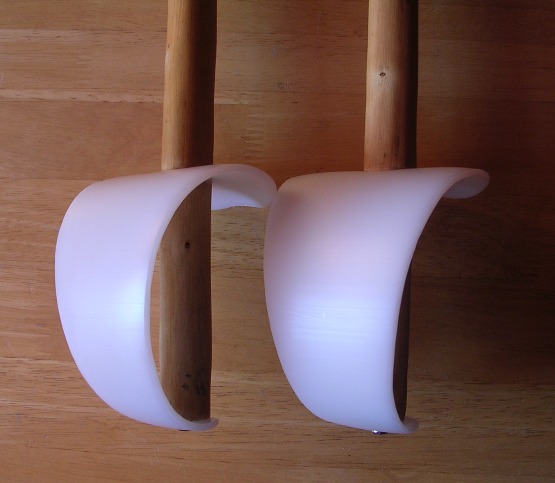
|
|
  |
 |
|
Julian Reynolds
Location: United Kingdom Joined: 30 Mar 2008
Posts: 271
|
 Posted: Wed 07 Sep, 2011 3:39 pm Post subject: Posted: Wed 07 Sep, 2011 3:39 pm Post subject: |
 |
|
|
Looking at those videos, only the first one seemed like it looked representative of a cutlass encounter, although a little too expert and well practiced for a common sailor (and they could do with another 10 people sharing the same space!). But the techniques were there. The latex sword guys was choreographed role-play. Utter nonsense.
|
|
  |
 |
|
Sean Manning
|
 Posted: Wed 07 Sep, 2011 5:50 pm Post subject: Posted: Wed 07 Sep, 2011 5:50 pm Post subject: |
 |
|
|
Sjouke, as far as I know we don't have any manuals on naval combat from the 17th or 18th centuries. Generally, lower class/untrained fighters imitated their upper class/expensively trained contemporaries. If you already have a few years of martial arts training, I would research broadsword styles around 1700 (google "Schola Swordsmanship Forum" for a list of sources) . If you don't, I would find a local school which offers good training in any short one-handed sword and study that! Some things are universal, and its hard to understand manuals unless you already understand how to fight.
|
|
  |
 |
|
Sjouke de Jong
|
 Posted: Sat 10 Sep, 2011 5:36 am Post subject: New insights Posted: Sat 10 Sep, 2011 5:36 am Post subject: New insights |
 |
|
He everyone.
I have done quite some research on Cutlass techniques of the late 17th - early 18th century, and I found some interesting things. Here are some of my findings.
I found that the Langes Messer (and falchion) techniques are very much like Cutlass techniques and that these techniques are most likely the forefather (so to say) of the 17th-18th century Cutlass techniques. This makes sense, because the Langes messer and Falchion are actually almost identical to the basics of the cutlass (accept for the guard)
I also found that the Cutlass is in fact a type of Backsword like the Broadsword and that therefor the techniques of these types of weapons are almost certainly identical when used in the same time period.
Indeed, there are late 17th - early 18th century texts which have specific instruction about fighting with the Backsword and the Broadsword. Like Zachary Wylde's English Master of Defence OR, The Gentleman's Al-a-mode Accomplish, 1711 http://www.sirwilliamhope.org/Library/Wylde/ And Sir William Hope's New Short and Easy Method of Fencing 1707 http://www.sirwilliamhope.org/Library/Hope/NewMethod/
But these (among other books I found) don't seem to be something I can work with...
Zachary Wylde's book doesn't have any illustrations (or not in this version) which means that it lacks examples of the moves that are described.
And William Hope's illustration seems to learn how to use the Smallsword, not the Backsword as the description says.
However, smallsword techniques might in fact be very useful when learning Pirate style Cutlass techniques. As I agree with what Tom Leoni said in this forum http://www.swordforum.com/forums/showthread.p...Smallsword
Upon close analysis, it can be theorized that each period's "cutting system" was intimately related to the understanding of fencing that was prevalent at the time.
This certainly makes sense and may indeed be the case. which would mean that the basic footwork, defense and thrusting of Cutlass art was similar if not identical to the art of smallsword fighting. It however doesn't tell how to execute proper cuts, which is the primary function of the Cutlass...
Back to the Broadsword. Does anyone know of another book which describes Broadsword or other Backsword (cutlass) techniques (with illustrations/examples) dating from 1680-1725?
One last thing, for those who believe Pirates (almost) only used the curved bladed cutlass, I have something interesting to show you (see attachments) Here you can see a number of (famous) Pirates wielding not a curved single edged cutlass, but a straight double edged broadsword (or cutlass) And one can also see 2 Pirates wielding another type of double edged short sword. (almost like the stereotype medieval sword, but shorter)
Yours sincerely,
Sjouke de Jong
 Attachment: 210.73 KB Attachment: 210.73 KB
Edward (Ned) Lowe wielding a Broadsword [ Download ]
 Attachment: 213.16 KB Attachment: 213.16 KB
Captain Martel wielding a Broadsword [ Download ]
 Attachment: 157.41 KB Attachment: 157.41 KB
George Lowther wielding another type of straight double edged short sword [ Download ]
 Attachment: 222.43 KB Attachment: 222.43 KB
John Phillips wielding another type of straight double edged short sword [ Download ]
|
|
    |
 |
Paul Hansen

|
 Posted: Mon 12 Sep, 2011 12:50 pm Post subject: Posted: Mon 12 Sep, 2011 12:50 pm Post subject: |
 |
|
|
What I found interesting in the first post was that both pirates had something in their left hand: a buckler and a boarding axe. Maybe the axe is there for illustration only, to show that axes were used, but the buckler was apparently used by some. This presents the problem of lack of sword-and-shield material.
|
|
  |
 |
|
Julian Reynolds
Location: United Kingdom Joined: 30 Mar 2008
Posts: 271
|
 Posted: Mon 12 Sep, 2011 3:34 pm Post subject: Posted: Mon 12 Sep, 2011 3:34 pm Post subject: |
 |
|
I think you have a number of mixed techniques there which are causing a little confusion.
Cutlass is nothing like smallsword. They are two completely different weapons, at the opposite ends of the spectrum in terms of function and fencing. Even using Hope's New method, which some would argue is a more 'practical' adaptation of smallsword than the gentlemanly weapon of the duel, you cannot get away from the fact that the smallsword is a straight light-bladed weapon designed for thrusting, and the cutlass is a curved heavy-bladed weapon designed for cutting. One would be used by a gentleman who had spent a lot of time learning how to use it proficiently, the other would be used by a common sailor who would have had a minimum of training in its use.......
You also mention backsword and broadsword. That they were carried by 'pirates' is undoubted, as well as many other types of weapons. But you were originally asking about cutlass techniques, and these are not cutlases, they are specific weapons in themselves, with their own fencing styles that you can learn in the salle (I do so every week, along with smallsword etc.). You can adapt backsword to cutlass, just as you can adapt langes messer/falchion/dussack to cutlass, and doing so will fill in the void left by the fact that there are no contemporary treatises for cutlass. You can't, however, adapt smallsword to cutlass.
You will find plenty to keep you occupied amongst these treatises:
http://www.fioredeiliberi.org/phpBB3/viewforu...bed163f400
but please don't waste your time with smallsword! Not unless you actually want to be a smallsword-wielding pirate! (by the way, it is perfectly plausible to use smallsword sucessfully against backsword - or cutlass)
Julian
|
|
  |
 |
|
Benjamin Floyd II
|
 Posted: Tue 13 Sep, 2011 5:35 am Post subject: Posted: Tue 13 Sep, 2011 5:35 am Post subject: |
 |
|
Dussack was very popular in Germany for a looong time. Attached are some pictorial proofs.  Note the dates on the file comments. If you want to learn cutlass techniques, you would not be far off with dussack/dussage/tesak/etc. As time progressed, the hilts became more complex as did a lot of weapons during the 17th century. An example of this is the "sinclair sabre": http://www.myArmoury.com/swor_dt_sinc.html or http://therionarms.com/reenact/therionarms_c1112.html Note the dates on the file comments. If you want to learn cutlass techniques, you would not be far off with dussack/dussage/tesak/etc. As time progressed, the hilts became more complex as did a lot of weapons during the 17th century. An example of this is the "sinclair sabre": http://www.myArmoury.com/swor_dt_sinc.html or http://therionarms.com/reenact/therionarms_c1112.html
 Attachment: 45.54 KB Attachment: 45.54 KB

1671
 Attachment: 94.95 KB Attachment: 94.95 KB
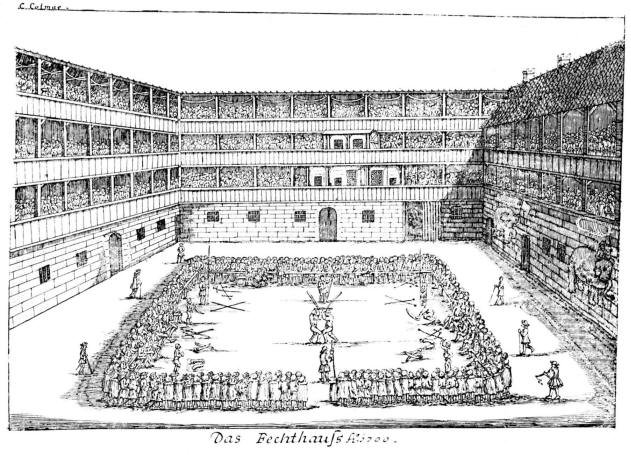
1700
 Attachment: 113.38 KB Attachment: 113.38 KB

1720
 Attachment: 71.06 KB Attachment: 71.06 KB
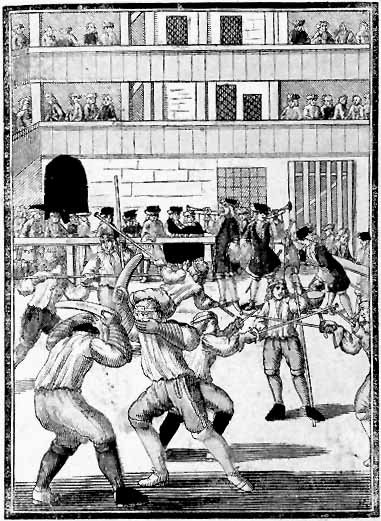
mid 18th century
 Attachment: 76.24 KB Attachment: 76.24 KB
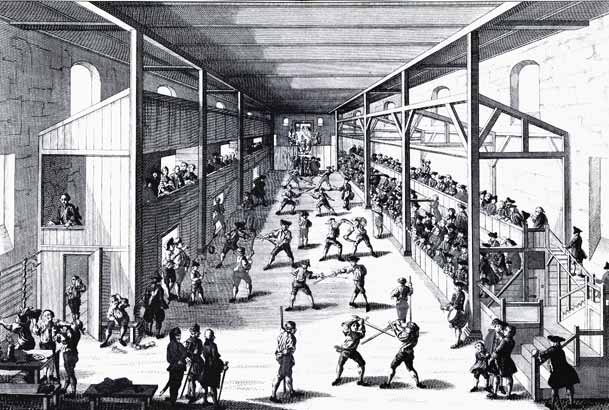
18th century
|
|
  |
 |
|
Benjamin Floyd II
|
 Posted: Tue 13 Sep, 2011 5:58 am Post subject: Posted: Tue 13 Sep, 2011 5:58 am Post subject: |
 |
|
| Julian Reynolds wrote: | The confined, explosive nature of the fighting was reflected in the techniques we practised:
The main guard was against the most common attack one would encounter with such a short-bladed weapon used in a confined space by a relative novice; a simple downwards cut into the head/shoulders. The cutlass was held just above the head across the body (ie. in the line of the shoulders), point slightly forward and lowered, and the blade supported by the offhand. Lean into the guard to add weight and strength to it. In this way, a powerful downward blow by an attacker with momentum could be blocked and deflected and a downward cut given back in riposte. Very basic! |
That guard in dussack by Joachim Meyer is the bogen (bow). Another good technique against a downward cut is versetzen (displacing/parrying) where you cut into the cut to change it's direction and then follow-up with a half-cut (molinet) or winden (winding) technique to move their weapon aside and cut/stab at the head/throat/shoulder.
| Julian Reynolds wrote: | | Guarding the torso from the next most common attack (a slash across the thorax or a thrust) was done with a similar guard to the above but lowered and turned through 90 degrees; vaguely similar to tierce but much 'tighter' ie. hilt down and just forward of the right hip (not held out in tierce), blade slightly angled across the body with the tip forward and supported from behind with the offhand. Again lean into the guard to add weight to it. A powerful cut into the body would be blocked and directed down into the guard, with the riposte being a thrust into the chest or face (or even a punch in the face with the guard!). |
This guard is called eben (boar). Honestly, you don't need to brace the weapon with the off hand on either of these guards when you do them correctly. I usually put my hand as a brace when I'm trying to go to grips on the other guy's weapon arm/wrist. When you brace it, it does two things. One, it puts your hand within a short distance of their arm for performing a grab. Two, it can stop the other weapon cold (instead of providing a glancing surface) to momentarily stop their arm so that it's easier to grab.
| Julian Reynolds wrote: | | And doing this 'en masse' shoulder to shoulder makes all the 'twirly' moulinets found in sabre/backsword cuts pretty redundant. It is very, very simple and works well at speed and in close proximity. And if your opponent blocks you, and you can't bludgeon your way through, roll around him and chop him down from behind! |
A half-cut (molinet-like motion) isn't just for show. You can use them to change the timing, distance, and angle of your attacks. If your weapon is short enough, you can do it in the space directly in front of you so you don't chop the guy next to you.
Another thing it sounds like you need to try is change your cuts into thrusts after/as/or before they are blocked. This will put your point into the guy in one motion (this is also advised in Meyer's dussack). Try it out.
| Julian Reynolds wrote: | | Good fun, especially against marines and their muskets/bayonets..... |
That'd be interesting. I'd want a buckler.
Last edited by Benjamin Floyd II on Tue 13 Sep, 2011 2:00 pm; edited 1 time in total
|
|
  |
 |
|
|
You cannot post new topics in this forum
You cannot reply to topics in this forum
You cannot edit your posts in this forum
You cannot delete your posts in this forum
You cannot vote in polls in this forum
You cannot attach files in this forum
You can download files in this forum
|
All contents © Copyright 2003-2025 myArmoury.com — All rights reserved
Discussion forums powered by phpBB © The phpBB Group
Switch to the Basic Low-bandwidth Version of the forum
|

